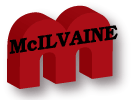
CATER Mask
Decisions
January 20, 2021
Webinar Agenda for Tomorrow
Speed is the Basis for the Webinar Tomorrow
A Push-Pull Program will Provide the Speed and
Efficacy
Validation of Fitted Mask Efficiency Still will
be Needed
Five Step Approach Needed
Eurofins has a Tested Quality Seal for Community
Masks
ATI Supplies Both Mask PFE and Resistance
Testers
Ambrust American Expands Meltblown Capacity
______________________________________________________________________________
Webinar Agenda for Tomorrow
Individuals are encouraged to present their
views in the webinar tomorrow. The format will
be to display the relevant material from
previous Alerts in chronological order. We will
then encourage discussion. People who have
already committed to making comments are listed.
January 20, 2021
Speed is the Basis for the Webinar Tomorrow
A Push-Pull Program will Provide the Speed and
Efficacy
Validation of Fitted Mask Efficiency Still will
be Needed
Five Step Approach Needed
Eurofins has Tested Quality Seal for Community
Masks
January 19, 2021
Join Us on Thursday to Debate the Mask Issues
Media Supply will be Substantial According to
Dave Rousse
·
Dave Rousse
Mobile Device to Insure Selection of the Mask
with the Right Fit
·
Keith Dellagrotta
Leveraging ASTM Label Initiative for Efficient
Public Masks
·
Erich Couch
Breathing Resistance, Filtration Efficiency and
Media Area
FFP 2 Masks Now Required in Retail Stores and
Public Transport in Austria and Germany
January 18, 2021
Sufficient Essential Braces can be Supplied to
Meet Needs
·
Sabrina Paseman
Quick Fit Testing Methods are Needed- How About
Thermal Imaging?
Some Thermal Imagers Already Recognize Face
Masks
How About the Temperature Scanners Presently
Being Used
January 15, 2021
Biden Mask Mandate Debate Next Thursday - Join
the Discussion
·
Chance for anyone to weigh in on any of the
issues
Review of Coronavirus Mask Decisions
the webinar will be recorded and available to
view in the webinar section of CMD.
To register for the event click on
http://www.mcilvainecompany.com/CATER/subscriber/default.htm
Speed is the Basis for the Webinar Tomorrow
In his inauguration speech this morning
President Biden spoke of speed and urgency in
dealing with COVID. He needs to know as quickly
as possible whether mask efficiency should be a
major factor in reducing COVID spread. The goal
of the webinar tomorrow is to help accelerate
the communication and decision making.
It is logical to ask why has McIlvaine
undertaken what would logically be the province
of an association or government body. The answer
is speed. McIlvaine has proven in past crises
that it can make a contribution when quick
decisions have to be made about air and water
issues.
At the time of the Gulf oil spill decisions had
to be immediately made as to whether chemical or
non-chemical O2 sensors would be used in the
undersea drones to chart the oil spill.
McIlvaine organized a series of webinars
in just a few days. Experts, operators and
governments shared valuable insights.
EPA was within days of promulgating the
1990 power plant air regulations when it was
discovered that all three methods for velocity
measurement had flaws. A series of McIlvaine
webinars including EPA, power plants,
consultants, and suppliers provided the needed
answers.
A failure of 2205 nickel alloy SO2 scrubbers
resulted in many hours of webinars in just a few
weeks as solutions were pursued for what turned
out to be a multibillion dollar problem.
A Push-Pull Program will Provide the Speed and
Efficacy
Erick Couch, tomorrow, will be advocating that
the Biden Administration mandate or endorse ASTM
labels which would specify performance in either
the 20-50% range or 50-100% range. He will
further emphasize that this range can be the
basis for further effort. The ASTM label can be
conceived as the Push effort in a two part
push-pull sequence.
In the push-pull concept you want to minimize
Push e.g. “require” and to maximize
Pull e.g. “incentivize ”.
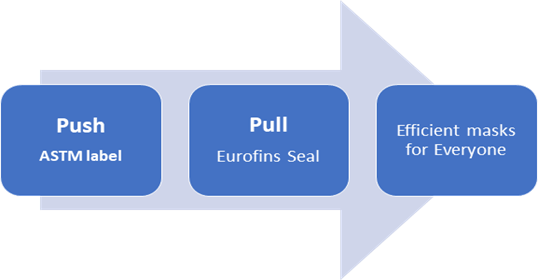 .
.
What incentives do individuals, universities,
fitness centers, and malls have to require
something more than the ASTM 50-100 label? The
answer is survival. Let’s say occupancy
and mask efficiency are directly proportional.
As a theater operator would you rather have 50%
or 100% of the seats filled.
The basic requirement
for anyone in public space can be the
ASTM 50-100 in the U.S. In Europe it will be the
tough regulations already in place (see below).
In addition there can be safe bubbles where
efficiency requirements higher than 50% are the
price of entry. Europe has 70% and 90%
efficiency levels. When people understand that
90% + 90% x 10% = 99%
whereas 70% + 70% x 30% = 91% and that
the virus risk is nine times lower with the 90%
masks there will be many safe bubble operators
who will opt for the higher efficiency. If the
hotel down the street has a 90% bubble the other
hotels will want to offer the same level of
safety.
The “Pull” safety level can be validated by a
seal similar to the Eurofins “Tested Quality
Seal” shown below. Eurofins with many thousands
of employees around the world is well positioned
to create a seal which the public will
recognize.
SGS is another large organization which could
create its own seal. A few organizations with
international reach can create competing seals.
A mask could carry both the ASTM 50-100 label
and the Tested Quality Seal which would show a
specific level of efficiency e.g. 90%.
The Tested Quality Seal validates not only the
theoretical performance of a mask but the
adherence to quality control throughout the
manufacturing and distribution process. The
quality control problems with a number of
Chinese masks demonstrates the need for quality
control validation.
Do we create a monopoly for a few large
organizations such as Eurofins or SGS? We can
avoid this by having sufficient numbers of
Tested Quality Seal providers. A large testing
organization such as Nelson Laboratories can
elect to partner with quality control
capabilities such as MPR and create an
alternative Tested Quality Seal.
Validation of Fitted Mask Efficiency Still will
be Needed
Some mask companies such as Vogmask have five
different sizes and spend a lot of time making
sure customers wear masks properly. Keith
Dellagrotta will be speaking tomorrow about
using the iPhone for a facial scan and then
analysis of the Vogmask fit. We also asked Keith
about the broader use for people entering a
facility. He replied “As an ER doctor, I am very
familiar with the annual N95 fit test
requirement by OSHA. Our technology involving
just the facial scan and virtual overlay of the
mask would be simpler and much less subjective.
We have not pursued this pathway yet but it
remains on our radar.”
Our recent Alerts have pursued thermal imaging
at entrances as a way to validate mask fit.
Alternatively just a visual inspection
may be an option. Mask fit inspection will be
both difficult and politically challenging. But
with reference to our automobile safety analysis
in the previous Alert it is achievable. It may
take time. After all seat belts were only
required decades after people started driving.
On the other hand operators of safe bubbles will
not want to take chances. A restaurant is less
worried about being shut down for sanitary
violations than it is in sickening a number of
people and creating damage to its public image.
Five Step Approach Needed

Success depends on a five-stage sequence. Mask
quality has to be addressed starting with
manufacturing and ending with the final fit
inspection.
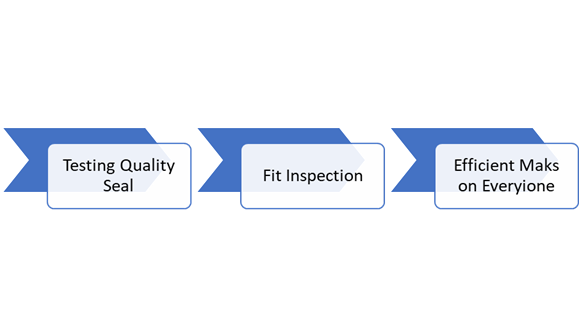
Fit Inspection will be the last step in a
process which will insure efficient masks for
everyone.
the process has built in flexibility.
Much of it can be implemented immediately. Other
parts will need to be improved over time.
Since speed is crtical the five step
process is a route which will most quickly
accomplish the objectives
Eurofins has a Tested Quality Seal for Community
Masks
Eurofins provides high-standard quality
assurance and control services throughout the
supply chain.
Manufacturers are responsible for ensuring that
the masks they supply and put on the market
comply with safety and effectiveness
requirements and the standards required in the
country in which they are sold. Eurofins
laboratories are ISO/IEC17025:2017 accredited
for Particulate Filtration Efficiency testing
(PFE), Bacterial Filtration Efficiency testing
(BFE) and differential pressure (breathability),
delivering precise, reliable and accurate
testing results to customers for EN, ISO and
ASTM test methods. Another important
consideration is the information made available
to consumers at the point of purchase.
Well-designed product specifications and claims
help to ensure that the user can easily and
correctly access, understand and use the mask.
Eurofins offers check service for marking,
labelling and instructions of use, according to
the recommendations by the national Authorities.
Tested Quality Seal
In an effort to provide
clients with proof of compliance for
hygienic masks, Eurofins experts have developed
the Tested Quality Seal for Community masks,
which will be granted to masks meeting the
thoroughly designed testing protocols.
Quality Assurance and Control throughout the
Supply Chain: Whatever the role in the supply
chain, it’s important to safeguard the
reputation of the brand and/or that of the
client. From suppliers’ assessments and R&D
support to regulatory guidance and supply chain
mapping, all the way through to compliance and
bespoke testing, QC inspections, failure
analysis and market surveillance, Eurofins cover
every stage of the product’s quality journey.

Marking checks on labels, packaging and
instructions for use: Marking on the product,
whether directly or on a label, and/or on its
packaging and instruction manual, is mandatory
and must be displayed in the applicable official
domestic language(s) and observe the wording as
defined in the country-specific legislation.
Eurofins’ label and marking check service
includes: • Completion of name, trademark,
address and contact details of the responsible
actor (producer or importer) • Product batch ID
(whenever applicable) • If tested against the
CWA document: “Community face coverings CWA”,
followed by the version of the CWA document
concerned • The filtration efficiency level,
method used and standard • Durability i.e.
reusable or disposable • Targeted user age e.g.
child or adult • Restriction warning e.g. “Not
suitable for children under 3 years of age”.
Eurofins experts
have developed the Tested Quality seal for
Community masks, which will be granted to masks
meeting the thoroughly designed testing
protocols
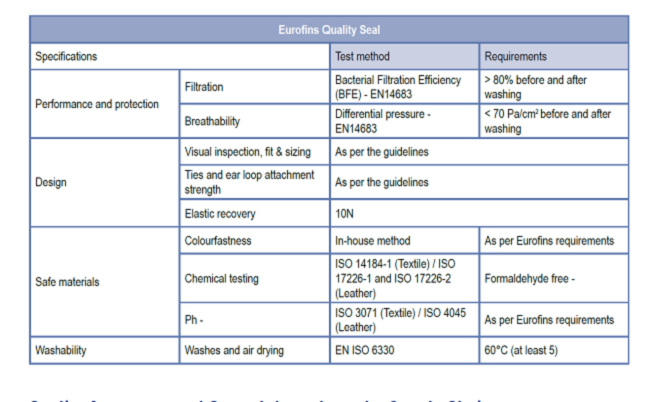
The specific requirements in Europe and
individual countries are shown below.
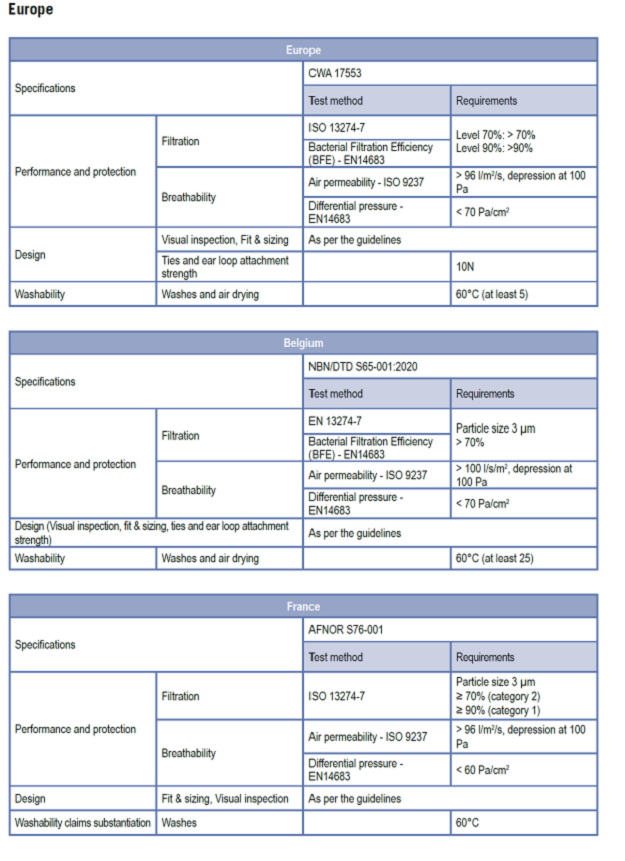
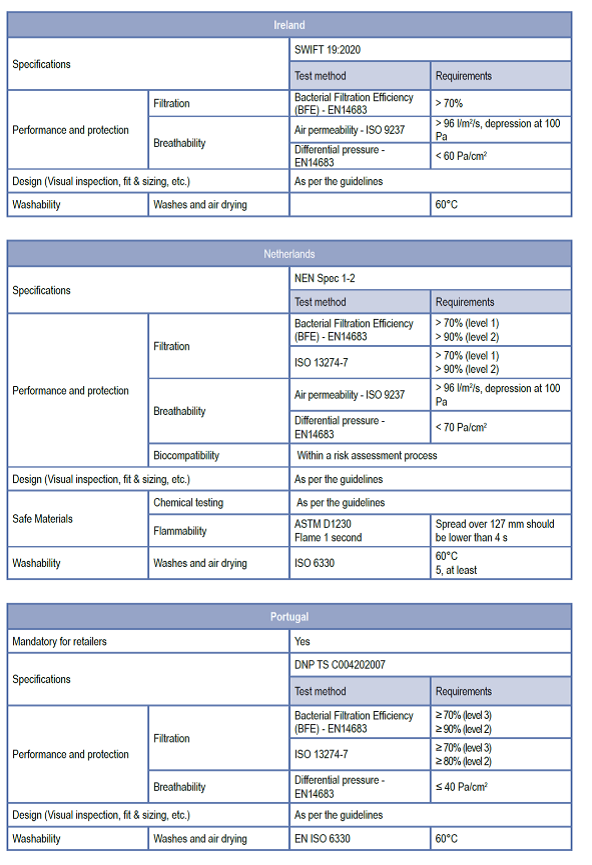
Details on other European regulations are also
provided on the Eurofins site at
https://cdnmedia.eurofins.com/corporate-eurofins/media/12153917/ef-brochure-community-masks-en.pdf
ATI Supplies Both Mask PFE and Resistance
Testers
Mask Particle Filtration Efficiency (PFE) Tester
is used to test the particle filtration
efficiency (oil or non-oil particle) of face
masks, mask raw fabric (meltblown non-woven),
results in percentage level, such N95 means 95%
filtration level.
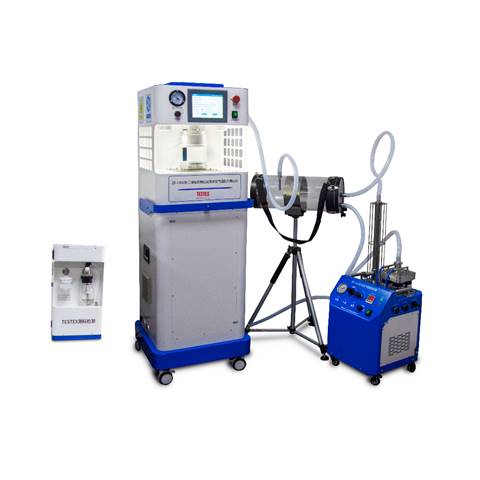
Mask Respiratory Resistance Tester adopts a
replaceable head-shape model, can test varied
mask sizes for adults or children; Equipped with
a high-quality flowmeter providing steady
airflow, which increases the accuracy of the
resistance testing results.
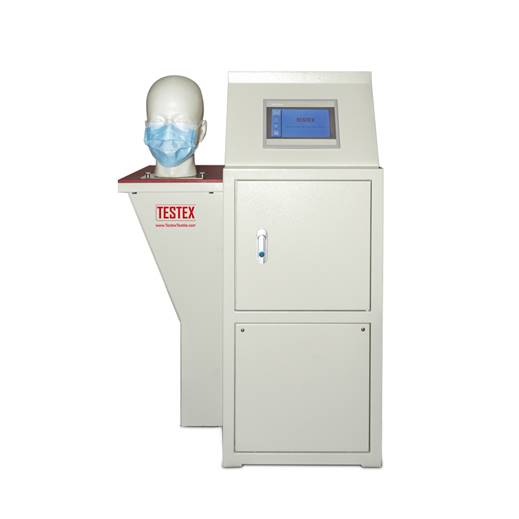
SPECIFICATIONS:
-
Air source: air compressor
-
Flowmeter range: 0L/min ~
100L/min, accuracy is ±2%.
-
Micro-pressure measuring range:
-1000Pa~1000Pa,
precision 1Pa
-
Pump capacity requirement:
≥100L/min
-
Constant ventilation volume:
(85±1)L/min
-
Display mode: touch screen
display
-
Test time: As required,
adjustable
-
Automatically record the test
data: Yes
-
Power supply: AC220V±10%, 50Hz,
0.6KW
Ambrust American Expands Meltblown Capacity
With first responders across the country
suffering from shortages, PPE manufacturer Armbrust
American today announced that its factories are
now capable of producing meltblown, the
non-woven fabric material that is crucial to
filtering out microscopic particulate matter
such as the coronavirus.
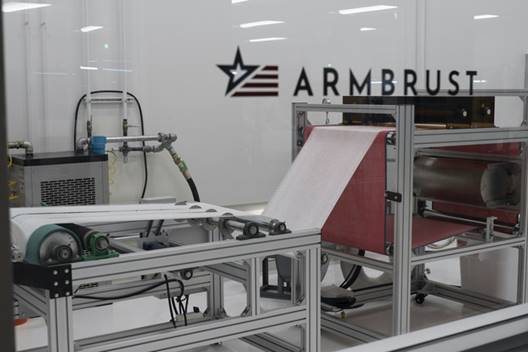
Armbrust American's Texas-based medical mask
facility & meltblown machine.
In 2019 less than 3 million tons of meltblown
material was produced in China, which isn't
enough to manufacture a sufficient supply of PPE
like surgical and N95 respirator masks. The move
to produce its own meltblown allows Armbrust
American to control costs and better scale its
operations so that America's first responders
have the protection they need.
"Nine months into this pandemic, a lack of
domestic manufacturing is the only explanation
for why America still does not have enough PPE,"
said Founder and CEO Lloyd Armbrust.
"Investing to produce our own meltblown means we
aren't dependent on other countries, who are
more than willing to profit from our lack of
preparation."
Meltblown is made from plastic polypropylene
pellets that are melted down and "blown" into a
nonwoven fabric sheet, which then gets a static
charge to improve filter effectiveness. The
majority of meltblown material is manufactured
in China and sold to U.S. manufacturers at a
great cost. This has caused prices for PPE to
skyrocket, with some health service providers
now passing those exuberant expenses to patients
in the form of surcharges, according to recent reports.
"PPE prices skyrocketed globally during this
pandemic because China controls the supply, and
the situation is scarcely better today. So when
demand for PPE rises, America is once again at
their mercy, unable to deliver products and held
hostage to rampant price gouging," said Armbrust
American President Landon Morales. "We can't
rely on other countries to supply masks. America
needs to take care of itself."
Armbrust is manufacturing a new Electrostatic
Armor ® Meltblown, the company's new proprietary
blend of meltblown filtration material that more
easily adds a static charge and allows those
wearing a mask greater breathability. Despite
the premium quality and proprietary process, the
company is still able to keep costs lower than
what is sold from China.
"The shortage has caused people to rely on
reusable cloth masks that offer as little as 10%
protection against the coronavirus. And now our
hospitals are subsidizing Chinese companies to
produce something that can be made better and
cheaper at home," Armbrust said.
